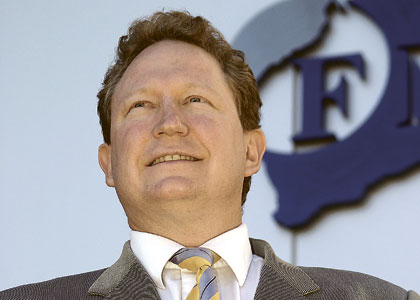Andrew Forrest was straight back to work following his recent High Court win ... after throwing a few jabs at ASIC. Tim Treadgold reports.


Andrew Forrest was straight back to work following his recent High Court win ... after throwing a few jabs at ASIC. Tim Treadgold reports.
ONCE a boxer, always a boxer; that’s a neat way of describing how Andrew Forrest, a keen amateur fighter, has done business in the past, and what can be expected in the future.
While other people might have adopted a lower profile after last week’s knockout High Court win against Australia’s corporate cops, and a nasty debt scare a few weeks earlier, Mr Forrest has been in training for his next fight.
High on his list is essential repair work at Fortescue Metals Group, which was forced to put expansion projects in limbo during the debt crisis.
Mr Forrest must also find time for a return bout with the federal government in the High Court, this time orchestrating a challenge against the government’s controversial Minerals Resource Rent Tax.
Few lawyers give Mr Forrest’s anti-MRRT case much chance of success, though the same people said the same thing when he took the Australian Securities and Investments Commission to the High Court to clear his name of allegations that he misled investors in a 2004 statement about a ‘binding’ contract with potential Chinese partners.
Battering ASIC in the High Court, as satisfying as it must have been, has generated a curious reaction from Mr Forrest. While there might have been some private breast-beating, his public reaction has been quite different, using the win as an opportunity to clear the way for future deals.
Shortly after the verdict, Mr Forrest adopted a stance that required an understanding of boxing, and the use of charm as a weapon, by holding out an olive branch to the punch-drunk staff at ASIC who had failed in their long-running endeavour to prove he misled investors.
In a business equivalent of visiting the change rooms of an opponent after bashing him senseless in the ring, Mr Forrest called the acting chairman of ASIC, Belinda Gibson, to make a few suggestions about how Australian corporate law might be better applied.
Cheeky? Perhaps. But in keeping with Mr Forrest’s pugnacious style, the call had a touch of the sporting motto of honouring your opponent, while also reminding them that you’re the winner and they had best not forget it – or there’s more where that last punch came from.
Mr Forrest argues he was merely seeking the best for Australia, telling The Sydney Morning Herald that: “I believe being on the inside of the other side I can help them (ASIC) seriously, with their thinking, how to get a better result for Australia.”
That could be a genuinely-held belief, but it sits interestingly with a comment made about the man in 2008, just before the first shipment of FMG ore sailed for China: “There are two Twiggy Forrests,” said a mining analyst who asked not to be named. “One is a charming, charismatic doer. The other is a ruthless over-promoter.”
Which Twiggy called ASIC is for him to know and for others to guess, but it should not be overlooked that scoring points by getting in close to an opponent is a common boxing technique.
What Mr Forrest was probably seeking by calling Ms Gibson was to remind ASIC that he’s a winner in business and the law.
Or, maybe he was simply turning on the charm in the same way he did when restructuring FMG’s debt in the aftermath of the sharp mid-year iron ore price correction.
A former director of FMG, Ian Burston, said of Mr Forrest a few years ago: “Andrew could sell ice to the Eskimos.”
Keeping ASIC in the change rooms and away from his business interests is a way for Mr Forrest to signal that he is far from finished in building one of Australia’s great mining empires.
Iron ore is the engine-room of his best-known business, FMG, but it is not his only business interest that is starting to morph into a mining-finance house of the sort that once dominated the industry around the world.
Spare cash from iron ore has already been redirected into small punts on nickel and gold, while a staff of backroom bean counters in Mr Forrest’s most private company, The Metal Group, beaver away on other deals for their boss.
None of these secondary deals has yet produced a result anything like FMG, but the nature of an entrepreneur such as Mr Forrest means that he will continue to chip away in search of the next big win.
Poseidon, the modern-day replica of the original Mt Windarra nickel miner of 40 years ago, is struggling for profitability in a climate of low metal prices. Apex Minerals, the gold miner he has backed, is also struggling to master a complex and high-cost production process.
Side deals such as Poseidon and Apex will always be on the boil for Mr Forrest and The Metal Group, the private company that holds most of his 33 per cent stake in FMG – an investment currently valued at $3.7 billion.
Working out a way to utilise the value in his FMG shares – without being watered down by a share issue or by selling part of his controlling stake – is a priority for Mr Forrest, who far prefers building a business than the humdrum monotony of running a business.
The process of levering value off his paper fortune started last year when he stepped down as chief executive of FMG, a move that had the side benefit of being prepared should the High Court decision go against him.
With the ASIC case out of the way, Mr Forrest is now primed to get on with business, having also secured the future of FMG last month by replacing short-dated debt with a five-year, $4.5 billion facility, arranged by his long-term bankers, Credit Suisse and JP Morgan.
Armed with a fresh debt facility, Mr Forrest’s ‘to-do’ list is likely to start by getting FMG back on the expansion trail; not simply because he enjoys being seen as a success, more because FMG was badly caught out in the mid-year iron ore price slide with costs that are significantly higher than the other big Pilbara miners, BHP Billiton and Rio Tinto.
New, lower-cost mines, mothballed in the debt crisis, can now be re-started as an essential step in driving down costs in a business all about economies of scale; and that means shifting as many tonnes of ore as possible down its railway and over its port.
First revised target is likely to be a fresh start on the Kings mine, part of the Solomon Hub, which was mothballed during the debt crisis.
With a production target of 40 million tonnes a year, the $1.1 billion Kings mine is a key part of lifting FMG’s annual output to 155mt of iron ore a year.
For Forrest watchers the next few months will make for interesting viewing. It is possible that he will have learned how to better manage FMG debts, and will spend more time on boring day-to-day chores such as holding down costs.
But, beneath what is likely to be a calm exterior, Mr Forrest will be:
• egging on his legal team to give the Australian government a second black eye, if the High Court finds the MRRT unconstitutional.
• urging FMG management to resume expansion work;
• seeking fresh diversification deals for The Metals Group; and
• pushing ahead with his philanthropic work.
What he might also be tempted to do, but should resist, is become involved in next year’s Federal election, hoping his run of good luck will continue with a new government killing the MRRT if the High Court bid fails.
Australian politics, with its fondness for lopping tall poppies, is no place for a billionaire.






